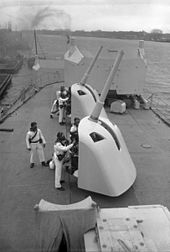
SMS Scharnhorst was an armored cruiser of the Imperial German Navy, built at the Blohm & Voss shipyard in Hamburg, Germany. She was the lead ship of her class, which included SMS Gneisenau. Scharnhorst and her sister were enlarged versions of the preceding Roon class; they were equipped with a greater number of main guns and were capable of a higher top speed. The ship was named after the Prussian military reformer General Gerhard von Scharnhorst and commissioned into service on 24 October 1907.

SMS Lützow was the second Derfflinger-class battlecruiser built by the German Kaiserliche Marine before World War I. Ordered as a replacement for the old protected cruiser Kaiserin Augusta, Lützow was launched on 29 November 1913, but not completed until 1916. Lützow was a sister ship to Derfflinger from which she differed slightly in that she was armed with an additional pair of 15 cm (5.9 inch) secondary guns and had an additional watertight compartment in her hull. She was named in honor of the Prussian general Ludwig Adolf Wilhelm von Lützow who fought in the Napoleonic Wars.

The Bayern class was a class of four super-dreadnought battleships built by the German Kaiserliche Marine. The class comprised Bayern, Baden, Sachsen, and Württemberg. Construction started on the ships shortly before World War I; Baden was laid down in 1913, Bayern and Sachsen followed in 1914, and Württemberg, the final ship, was laid down in 1915. Only Baden and Bayern were completed, due to shipbuilding priorities changing as the war dragged on. It was determined that U-boats were more valuable to the war effort, and so work on new battleships was slowed and ultimately stopped altogether. As a result, Bayern and Baden were the last German battleships completed by the Kaiserliche Marine.
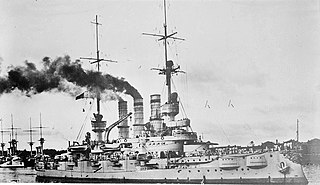
SMS Schlesien was one of five Deutschland-class pre-dreadnought battleships built for the German Kaiserliche Marine between 1904 and 1906. Named after the German province of Silesia, Schlesien was laid down at the Schichau-Werke shipyard in Danzig on 19 November 1904, launched on 28 May 1906, and commissioned on 5 May 1908. She was armed with a battery of four 28 cm (11 in) guns and had a top speed of 18 knots. The ships of her class were already outdated by the time they entered service, as they were inferior in size, armor, firepower, and speed to the revolutionary new British battleship HMS Dreadnought.

SMS Pommern was one of five Deutschland-class pre-dreadnought battleships built for the Kaiserliche Marine between 1904 and 1906. Named after the Prussian province of Pomerania, she was built at the AG Vulcan yard at Stettin, Germany, where she was laid down on 22 March 1904 and launched on 2 December 1905. She was commissioned into the navy on 6 August 1907. The ship was armed with a battery of four 28 cm (11 in) guns and had a top speed of 18 knots. The ships of her class were already outdated by the time they entered the service, being inferior in size, armor, firepower, and speed to the revolutionary new battleship HMS Dreadnought.

The Brandenburg class consisted of four pre-dreadnought battleships built for the German Kaiserliche Marine, the first modern battleships of the fleet. The four ships of the class—Brandenburg, Wörth, Weissenburg, and Kurfürst Friedrich Wilhelm—were the first ocean-going capital ships built for the German fleet in nearly two decades, owing to reluctance in the Reichstag to fund large projects. They followed a series of small coastal defense ships, and though in retrospect they anticipated the buildup that created the High Seas Fleet, they were ordered as part of a construction program that reflected the strategic and tactical confusion that affected many navies in the 1880s. The design process that resulted in the Brandenburg class was very lengthy, with proposals that ranged from outdated casemate ships to versions with two twin-gun turrets placed side by side. The designers ultimately settled on ships that were armed with an unusual main battery of six 28 cm (11 in) guns at a time when all foreign battleships were built with four or fewer heavy guns.

The Kaiser Friedrich III class consisted of five pre-dreadnought battleships of the Imperial German Navy; all ships of the class were named for German emperors. The ships were Kaiser Friedrich III, Kaiser Wilhelm II, Kaiser Wilhelm der Grosse, Kaiser Barbarossa, and Kaiser Karl der Grosse, all built between 1895 and 1901. The class saw the introduction of the traditional armament layout for German battleships prior to the advent of the dreadnought type of battleship in the early 1900s: four large-caliber guns, but of comparatively smaller size compared to their contemporaries, in two gun turrets. The German adoption of smaller guns was a result of a preference for higher volumes of fire over weight of shell. The Kaiser Friedrich III class also standardized the use of three screws for battleships and introduced water-tube boilers and Krupp cemented armor.
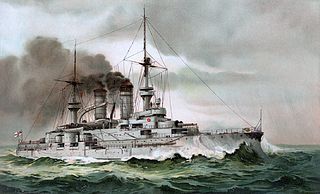
The Wittelsbach-class battleships were a group of five pre-dreadnought battleships built for the German Kaiserliche Marine in the early 1900s. They were the first battleships ordered under the Second Navy Law of 1898, part of Admiral Alfred von Tirpitz's fleet expansion program. The class comprised the lead ship, Wittelsbach, and Wettin, Zähringen, Schwaben, and Mecklenburg. All five ships were laid down between 1899 and 1900 and were finished by 1904. The ships of the Wittelsbach class were similar in appearance to their predecessors in the Kaiser Friedrich III class, but had a more extensive armor belt and a flush main deck, as opposed to the lower quarterdeck of the previous class. Both classes carried a battery of four 24 cm (9.4 in) guns in two twin-gun turrets.

The Braunschweig-class battleships were a group of five pre-dreadnought battleships of the German Kaiserliche Marine built in the early 1900s. They were the first class of battleships authorized under the Second Naval Law, a major naval expansion program. The class comprised five ships—Braunschweig, Elsass, Hessen, Preussen, and Lothringen—and they were an improvement over the preceding Wittelsbach class. The Braunschweigs mounted a more powerful armament of 28 cm (11 in) and 17 cm (6.7 in) guns. Less than two years after the first members of the class entered service, the ships were rendered obsolescent by the British all-big-gun battleship Dreadnought, which curtailed their careers.
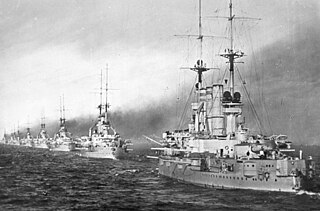
The Deutschland class was a group of five pre-dreadnought battleships built for the German Kaiserliche Marine, the last vessels of that type to be built in Germany. The class comprised Deutschland, the lead ship, Hannover, Pommern, Schlesien, and Schleswig-Holstein. The ships closely resembled those of the preceding Braunschweig class, but with stronger armor and a rearranged secondary battery. Built between 1903 and 1908, they were completed after the launch of the revolutionary British all-big-gun battleship HMS Dreadnought in 1906. As a result, they were obsolescent before entering service. The ships nevertheless saw extensive service in the High Seas Fleet, Germany's primary naval formation, through the late 1900s and early 1910s, when they were used for training, which included overseas cruises.

The Derfflinger class was a class of three battlecruisers of the Imperial German Navy. The ships were ordered for the 1912–13 Naval Building Program of the German Imperial Navy as a reply to the Royal Navy's two new Lion-class battlecruisers that had been launched a few years earlier. The preceding Moltke class and the incrementally improved Seydlitz represented the end of the evolution of Germany's first generation of battlecruisers. The Derfflinger class had considerable improvements, including a larger primary armament, all of which was mounted on the centerline. The ships were also larger than the preceding classes. The Derfflinger class used a similar propulsion system, and as a result of the increased displacement were slightly slower.

The Roon class was a pair of armored cruisers built for the German Kaiserliche Marine in the 1900s. The two ships of the class, Roon and Yorck, closely resembled the earlier Prinz Adalbert-class cruisers upon which they were based. The Roon class incorporated slight incremental improvements, including a pair of extra boilers. The ships were easily distinguished from their predecessors by the addition of a fourth funnel. Though the additional boilers were meant to increase the ships' speed, both vessels failed to reach their designed top speed. In addition, the ships had comparatively light armament and thin armor protection, so they compared poorly with their foreign contemporaries, particularly the armored cruisers of their primary opponent, the British Royal Navy.

SMS Yorck was the second and final ship of the Roon class of armored cruisers built for the German Kaiserliche Marine as part of a major naval expansion program aimed at strengthening the fleet. Yorck was named for Ludwig Yorck von Wartenburg, a Prussian field marshal. She was laid down in 1903 at the Blohm & Voss shipyard in Hamburg, launched in May 1904, and commissioned in November 1905. The ship was armed with a main battery of four 21 cm (8.3 in) guns and had a top speed of 20.4 knots. Like many of the late armored cruisers, Yorck was quickly rendered obsolescent by the advent of the battlecruiser; as a result, her peacetime career was limited.

The Prinz Adalbert class was a group of two armored cruisers built for the German Kaiserliche Marine under the terms of the Second Naval Law. Two ships of the class were built, Prinz Adalbert and Friedrich Carl, between 1900 and 1904. The two ships were heavily based on the previous armored cruiser, Prinz Heinrich, with a series of incremental improvements. Their armor layout was revised slightly to improve internal protection and their main battery consisted of four 21 cm (8.3 in) guns instead of the two 24 cm (9.4 in) carried by Prinz Heinrich. The new ships also received more powerful propulsion systems, making them slightly faster. Prinz Adalbert spent her peacetime career as a gunnery training ship while Friedrich Carl initially served as the flagship of the fleet's reconnaissance forces. By 1909, she had been replaced by more modern cruisers and joined Prinz Adalbert as a training vessel.

The Scharnhorst class was the last class of traditional armored cruisers built by the German Kaiserliche Marine. The class comprised two ships, Scharnhorst and Gneisenau. They were larger than the Roon-class cruisers that preceded them; the extra size was used primarily to increase the main armament of 21 cm (8.2 inch) guns from four to eight. The ships were the first German cruisers to reach equality with their British counterparts. The ships were named after 19th century Prussian army reformers, Gerhard von Scharnhorst and August von Gneisenau.
The Ersatz Yorck class was a group of three battlecruisers ordered but not completed for the German Kaiserliche Marine in 1916. The three ships had originally been ordered as additions to the Mackensen class, but developments abroad, particularly the British Renown-class battlecruisers, led to the navy re-designing the ships. The primary change was an increase of the main battery from eight 35-centimeter (14 in) guns to eight 38 cm (15 in) weapons. Work on the first ship had already begun by the time the navy decided to re-design the ships, so the design staff was constrained by the need to use the material already assembled.
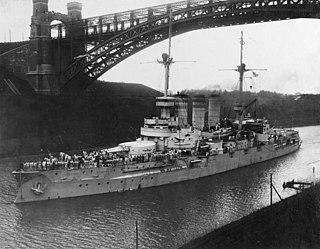
SMS Lothringen was the last of five pre-dreadnought battleships of the Braunschweig class, built for the German Kaiserliche Marine. She was laid down in December 1902, was launched in May 1904, and was commissioned in May 1906. She was named for the then-German province of Lothringen. The ship was armed with a battery of four 28 cm (11 in) guns and had a top speed of 18 knots. Like all other pre-dreadnoughts built around the turn of the century, Lothringen was quickly made obsolete by the launching of the revolutionary HMS Dreadnought in 1906; as a result, her career as a front-line battleship was cut short.

L 20e α was a design for a class of battleships to be built in 1918 for the German Kaiserliche Marine during World War I. Design work on the class of battleship to succeed the Bayern-class battleships began in 1914, but the outbreak of World War I in July 1914 led to these plans being shelved. Work resumed in early 1916 and lessons from the Battle of Jutland, fought later that year, were incorporated into the design. Reinhard Scheer, the commander of the fleet, wanted larger main guns and a higher top speed than earlier vessels, to combat the latest ships in the British Royal Navy. A variety of proposals were submitted, with armament ranging from the same eight 38 cm (15 in) guns of the Bayern class to eight 42 cm (16.5 in) guns.

SMS Nürnberg, named after the Bavarian city of Nuremberg, was a Königsberg-class light cruiser built for the German Imperial Navy. Her sisters included Königsberg, Stettin, and Stuttgart. She was built by the Imperial Dockyard in Kiel, laid down in early 1906 and launched in August of that year. She was completed in April 1908. Nürnberg was armed with ten 4.1-inch (100 mm) guns, eight 5.2 cm (2.0 in) SK L/55 guns, and two submerged torpedo tubes. Her top speed was 23.4 knots.


